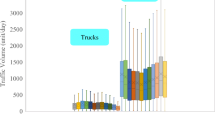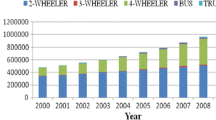Abstract
All major cities in India are facing severe environmental threats in the form of extremely higher levels of CO2, CO, HC, and NOx. Vehicular emissions are one of the major contributors to these pollution levels. To estimate the impact of traffic on urban air quality, it is necessary to measure vehicular emissions. The driving cycle (DC) is one of the critical components of various vehicle emission estimation procedures. Heterogeneous traffic conditions in India make researchers focus on case-specific and class-specific driving cycles for the estimation of emissions. In this regard, the study proposed a methodology to develop a real-world driving cycle (RWDC) for passenger cars and estimating emissions based on the driving cycle. Three routes in Hyderabad city are selected as a study area. The on-board measurement technique was used for the data collection, and Racelogic PBox is used for the same. Micro-trip analysis was done for constructing a real-world driving cycle. A comprehensive modal emission model (CMEM) was used to estimate CO, HC, and NOx emissions from passenger cars using their corresponding driving cycles. The total duration of the RWDC obtained for a passenger car is 2277 s. The fuel consumption rate obtained from the data is 110 g/km. The study needs to be extended to other vehicle classes for accurate estimation of emissions in the study area or region.
Access this chapter
Tax calculation will be finalised at checkout
Purchases are for personal use only
Similar content being viewed by others
References
Saija S, Romano D (2002) A methodology for the estimation of road transport air emissions in urban areas of Italy. Atmos Environ 36(34):5377–5383
Bata R, Yasser Y, Wang W, Lyons D, Gambino M, Rideout G (1994) Heavy duty testing cycles: survey and comparison. SAE technical paper series no. 942263, Washington, DC
MoRTH (2010) Details of standards for emission of gaseous pollutants from petrol engine vehicles and test procedures effective from 1st April 1991. MoRTH/CMVR/TAP-115/116, 2(4)
Yu L, Zhang X, Qiao F, Qi Y (2010) Genetic algorithm-based approach to develop driving schedules to evaluate greenhouse gas emissions from light-duty vehicles. Transp Res Rec 2191:166–173
Kamble SH, Mathew TV, Sharma GK (2009) Development of real-world driving cycle: a case study of Pune, India. Transp Res Part D Transp Environ 14(2):132–140
Saleh W, Kumar R, Kirby H, Kumar P (2009) Real-world driving cycle for motorcycles in Edinburgh. Transp Res Part D Transp Environ 14(5):326–333
Hung WT, Tong HY, Lee CP (2007) Development of a practical driving cycle construction methodology: a case study in Hong Kong. Transp Res Part D Transp Environ 12(2):115–128
Esteve-Booth A, Muneer T, Kubie J, Kirby H (2002) A review of vehicular emission models and driving cycles. Proc Inst Mech Eng Part C J Mech Eng Sci 216:777–797
Tzirakis E, Pitsas K, Zannikos F, Stournas S (2006) Vehicle emissions and driving cycles: comparison of the Athens driving cycle (Adc) with Ece-15 and European driving cycle (EDC). Global NEST J 8:282–290
Kenworthy J, Newman P (1982) A driving cycle for Perth: methodology and preliminary results. In: Proceedings of the joint SAE-A/ARRB 2nd conference on traffic, energy, and emissions, Melbourne
Tong HY, Hung WT, Cheung CS (1999) Development of a driving cycle for Hong Kong. Atmos Environ 33:2323–2335
Tong HY, Hung WT (2010) A framework for developing driving cycles with on-road driving data. Transp Rev 30(5):589–615
Nesamani KS, Subramanian KP (2011) Development of a driving cycle for intra-city buses in Chennai, India. Atmos Environ 45:5469–5476
Chugh S, Kumar P, Muralidharan M, Mukesh Kumar B, Sitanathan M, Gupta A, Basu B, Malhotra RK (2012) Development of Delhi driving cycle: a tool for realistic assessment of exhaust emissions from passenger cars in Delhi. SAE technical paper 2012-01-0877
Adak P, Sahu R, Elumalai SP (2016) Development of emission factors for motorcycles and shared auto-rickshaws using real-world driving cycle for a typical Indian city. Sci Total Environ 544:299–308
Perugu H (2018) Emission modelling of light-duty vehicles in India using the revamped VSP-based MOVES model: the case study of Hyderabad. Transp Res Part D Transp Environ 68:150–163
Saikiran M, Verma A (2018) A novel methodology for construction of driving cycles for Indian cities. Transp Res Part D Transp Environ 65:725–735
Barth M, An F, Younglove T, Scora G, Levine C (2000) Development of a comprehensive modal emissions model. Final report for NCHRP project 25-11. Transportation Research Board
Ahn K, Trani AA, Rakha H, Aerde MV (1999) Microscopic fuel consumption and emission models. In: Proceedings of the 78th annual meeting of the transportation research board, Washington, DC
Scora G, Berth M (2006) Comprehensive modal emission model (CMEM): user’s guide. University of California, Riverside, Centre for Environmental Research and Technology, NCHRP, Project 25-11
Author information
Authors and Affiliations
Editor information
Editors and Affiliations
Rights and permissions
Copyright information
© 2022 The Author(s), under exclusive license to Springer Nature Singapore Pte Ltd.
About this paper
Cite this paper
Subbarao, S.S.V., Deepti, A., Amit, H., Akshay, A., Charan, S.K. (2022). Emission Modelling of Passenger Cars in India: A Case of Hyderabad City. In: Parida, M., Maji, A., Velmurugan, S., Das, A. (eds) Proceedings of the Fifth International Conference of Transportation Research Group of India . Lecture Notes in Civil Engineering, vol 220. Springer, Singapore. https://doi.org/10.1007/978-981-16-9925-2_24
Download citation
DOI: https://doi.org/10.1007/978-981-16-9925-2_24
Published:
Publisher Name: Springer, Singapore
Print ISBN: 978-981-16-9924-5
Online ISBN: 978-981-16-9925-2
eBook Packages: EngineeringEngineering (R0)




